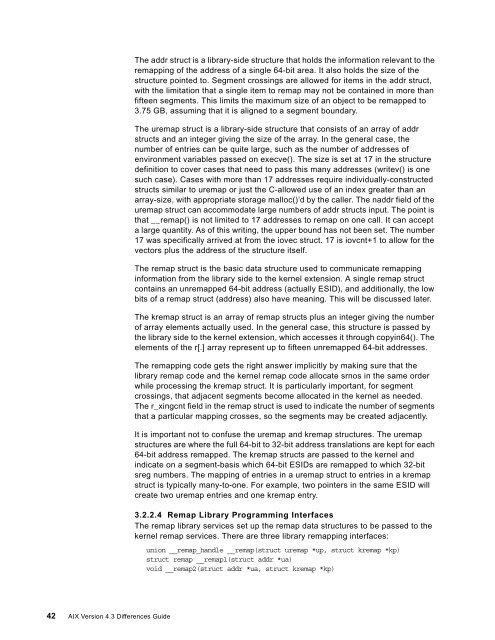AIX Version 4.3 Differences Guide
AIX Version 4.3 Differences Guide
AIX Version 4.3 Differences Guide
You also want an ePaper? Increase the reach of your titles
YUMPU automatically turns print PDFs into web optimized ePapers that Google loves.
The addr struct is a library-side structure that holds the information relevant to the<br />
remapping of the address of a single 64-bit area. It also holds the size of the<br />
structure pointed to. Segment crossings are allowed for items in the addr struct,<br />
with the limitation that a single item to remap may not be contained in more than<br />
fifteen segments. This limits the maximum size of an object to be remapped to<br />
3.75 GB, assuming that it is aligned to a segment boundary.<br />
The uremap struct is a library-side structure that consists of an array of addr<br />
structs and an integer giving the size of the array. In the general case, the<br />
number of entries can be quite large, such as the number of addresses of<br />
environment variables passed on execve(). The size is set at 17 in the structure<br />
definition to cover cases that need to pass this many addresses (writev() is one<br />
such case). Cases with more than 17 addresses require individually-constructed<br />
structs similar to uremap or just the C-allowed use of an index greater than an<br />
array-size, with appropriate storage malloc()’d by the caller. The naddr field of the<br />
uremap struct can accommodate large numbers of addr structs input. The point is<br />
that __remap() is not limited to 17 addresses to remap on one call. It can accept<br />
a large quantity. As of this writing, the upper bound has not been set. The number<br />
17 was specifically arrived at from the iovec struct. 17 is iovcnt+1 to allow for the<br />
vectors plus the address of the structure itself.<br />
The remap struct is the basic data structure used to communicate remapping<br />
information from the library side to the kernel extension. A single remap struct<br />
contains an unremapped 64-bit address (actually ESID), and additionally, the low<br />
bits of a remap struct (address) also have meaning. This will be discussed later.<br />
The kremap struct is an array of remap structs plus an integer giving the number<br />
of array elements actually used. In the general case, this structure is passed by<br />
the library side to the kernel extension, which accesses it through copyin64(). The<br />
elements of the r[.] array represent up to fifteen unremapped 64-bit addresses.<br />
The remapping code gets the right answer implicitly by making sure that the<br />
library remap code and the kernel remap code allocate srnos in the same order<br />
while processing the kremap struct. It is particularly important, for segment<br />
crossings, that adjacent segments become allocated in the kernel as needed.<br />
The r_xingcnt field in the remap struct is used to indicate the number of segments<br />
that a particular mapping crosses, so the segments may be created adjacently.<br />
It is important not to confuse the uremap and kremap structures. The uremap<br />
structures are where the full 64-bit to 32-bit address translations are kept for each<br />
64-bit address remapped. The kremap structs are passed to the kernel and<br />
indicate on a segment-basis which 64-bit ESIDs are remapped to which 32-bit<br />
sreg numbers. The mapping of entries in a uremap struct to entries in a kremap<br />
struct is typically many-to-one. For example, two pointers in the same ESID will<br />
create two uremap entries and one kremap entry.<br />
3.2.2.4 Remap Library Programming Interfaces<br />
The remap library services set up the remap data structures to be passed to the<br />
kernel remap services. There are three library remapping interfaces:<br />
union __remap_handle __remap(struct uremap *up, struct kremap *kp)<br />
struct remap __remap1(struct addr *ua)<br />
void __remap2(struct addr *ua, struct kremap *kp)<br />
42 <strong>AIX</strong> <strong>Version</strong> <strong>4.3</strong> <strong>Differences</strong> <strong>Guide</strong>
















